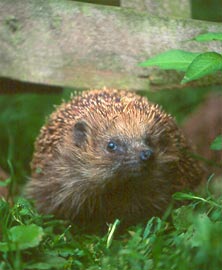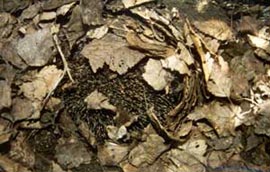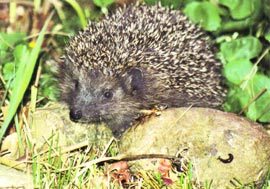Hedgehogs hibernate to survive the cold months. They are the only insectivore to hibernate. Hedgehogs can spend as long as five months asleep in their round, weatherproof, well insulated nests during winter when food is scarce. They roll up into a tight ball and stay for weeks or months in this position.
Torpor is a long-lasting sleep during which small changes to body temperature and metabolism take place. In torpor, sensitive animals can still react to external stimuli as they would when asleep: they are capable of waking up and becoming active in a very short time. The trigger for torpor is usually scarcity of food during cooler weather.
Hibernation, on the other hand, is completely different. The body temperature and entire metabolism are radically reduced. Hedgehogs barely react to mechanical stimuli. The body temperature is close to the ambient temperature. Only when it approaches freezing (0° Celsius) will the animal produce some warmth to maintain a minimum temperature.

When hedgehogs have gained enough weight, they will hibernate. The males hibernate first, depending on the weather, it can be as early as the beginning of October. The females follow when they have recovered from rearing their young. The juveniles hibernate last, because they need more time to gain sufficient weight. A young hedgehog should weigh at least 500 grammes by the beginning of November to survive his first hibernation in the wild.
In hibernation all vital functions are reduced to a bare minimum. Metabolic rate is reduced on average to 1.5% of that of an active animal:
- Body temperature sinks close to the ambient temperaturee
- Heart rate slows from approx. 200 to 2-12 beats per minute
- Respiration drops from 50 times to only 13 times a minute
- There are other rapid changes to the internal organs e.g. reduction in blood sugar level
When the ambient temperature falls to about 5° C the hedgehog produces some warmth to maintain a minimum temperature to prevent it freezing.
Hibernation lasts maximal 5 to 6 months. Short periods of arousal are normal, the hedgehogs awake, remain in their nests and soon go back into hibernation. Sometimes they are active for a few days and leave their nests. We assume this is to “reset” their metabolic functions back to normal after the massive reductions which take place during hibernation.
Hedgehogs take about 5-6 hours to enter into hibernation. In the next weeks and months they live off deposits of white fat which they laid down in summer and autumn. Short periods of arousal from hibernation are not unusual.
Arousal usually occurs when the ambient temperature remains at 10° C for some time. Arousal takes several hours and uses an enormous amount of energy, the hedgehog has special lobes of “brown fat” stored around his shoulders to do this. Blood circulation is increased five-fold, accelerated heart and respiration rates are accompanied by shivering of the muscles, particularly in the legs.
The hedgehog will lose, on average, 30% of his body weight during hibernation. The first priority for the emaciated hedgehog is to search for food, before the annual cycle of mating, reproduction and another hibernation can begin.





